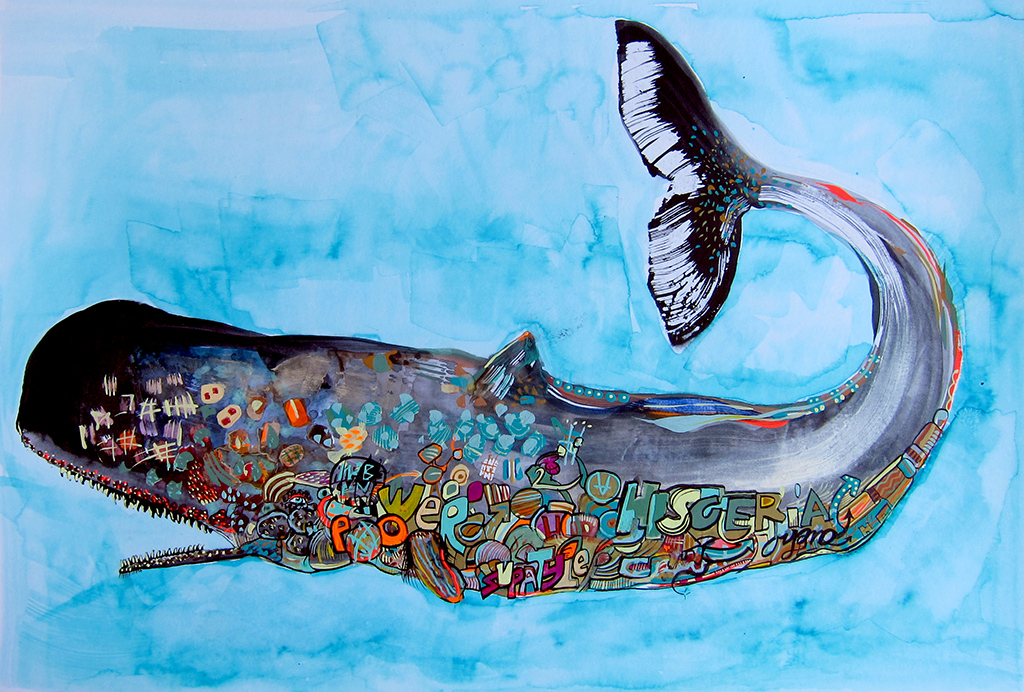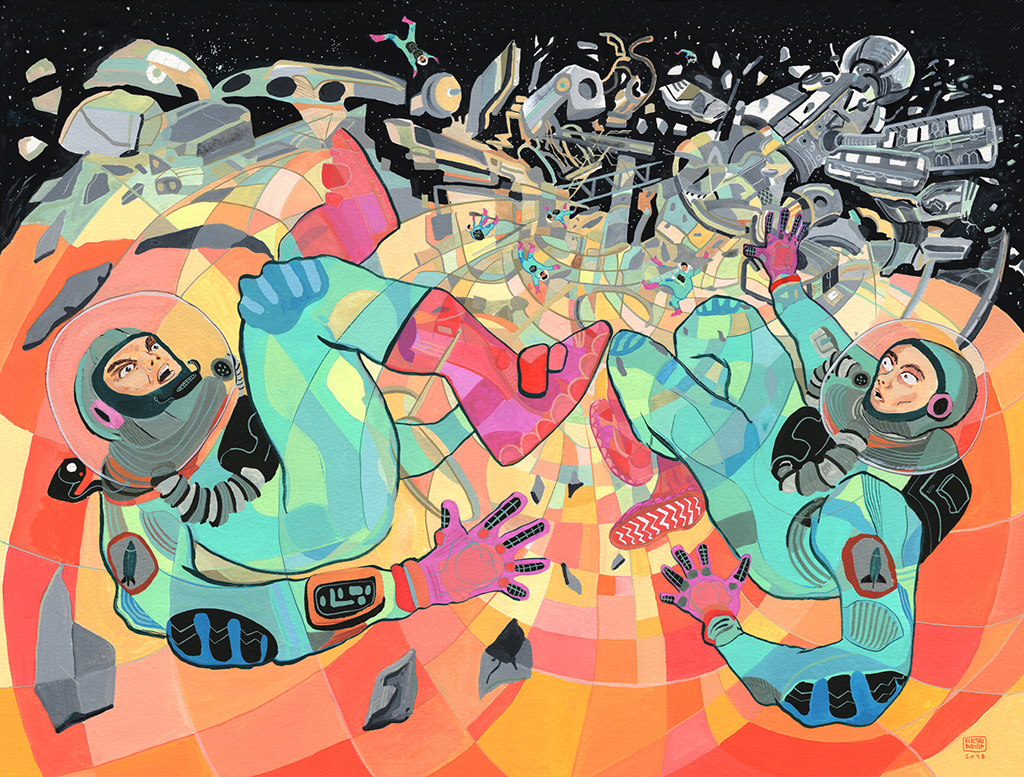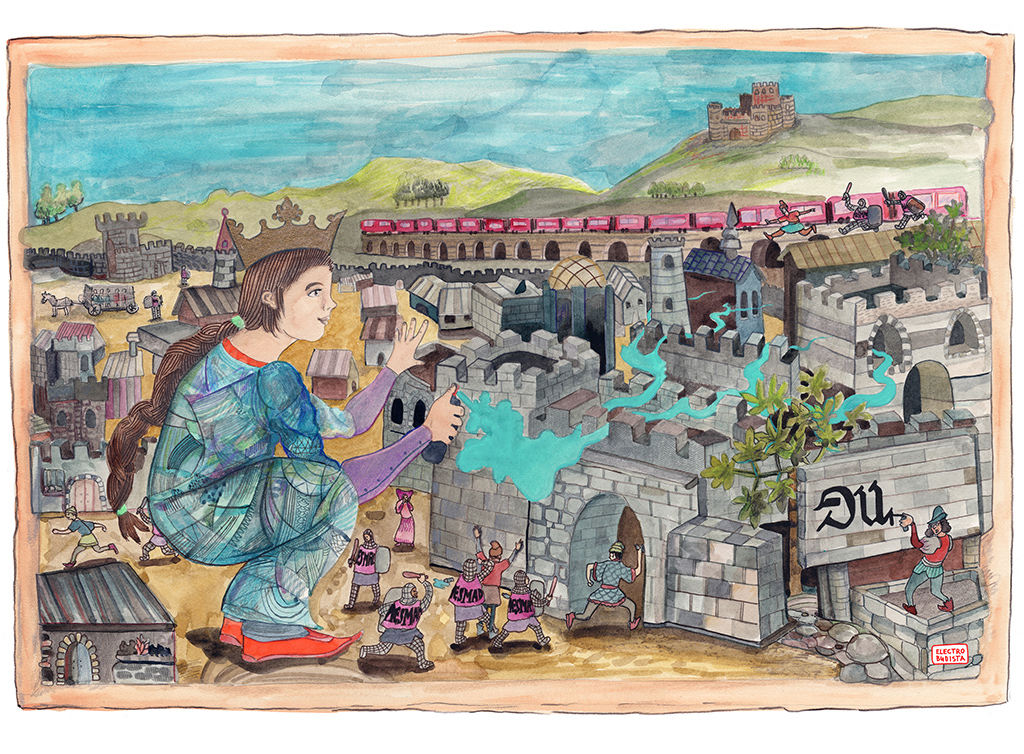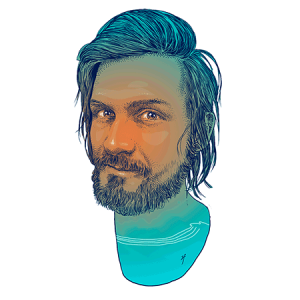My name is Adalberto Camperos A.K.A. ELECTROBUDISTA. I’m an artist, illustrator, writer, DJ and art historian from Colombia. My work revolves around the study of urban subcultures, visual and musical expressions that come from the streets of the cities and from the streams of global pop culture. I try to tackle those themes with humor and deep reflection at the same time. I make original artwork for exhibitions in galleries, private commissions and art fairs, mostly using analog mediums such as watercolor, gouache or acrylic paint. As an illustrator, I tend to work more digitally and try to collaborate with projects, companies, and people associated with cultural endeavors and art development such as editorials, science and music foundations, NGOs and civil rights organizations.
Is it difficult to make yourself known in the creative market?
I don’t think so. Actually it is very easy in this social media era to make oneself known all over the world.
What is difficult is to make people want to remember you, to work with you, to get along with you, to grow a community around your work and your public persona and to stay with you through the years. What is difficult is what always has been difficult: to establish a solid reputation.


Is the competition level high in your chosen field?
Nowadays I think competition is extremely high in all creative fields in every country. People got used to superlative levels of images, quality of projects, and experiences. People share every minute in their smartphones so many amazing videos and photos that the “normal” level for anything creative has risen dramatically in the last 10 years. Therefore, people expect too much and too fast from creative people around the world, adding an incredible pressure on us. Therefore, competition is as high as never. However, the illustration field in Colombia, I mean, the illustrators’ community, is very cooperative and very solidary. Everybody is trying to head in the same direction.
People share every minute in their smartphones so many amazing videos and photos that the “normal” level for anything creative has risen dramatically in the last 10 years.
Do you feel a lack of motivation sometimes, and how do you revive your creative energy?
Yeah sure, that’s a normal part of life, work and relationships. I don’t share my life only with creative people, I have friends who are lawyers, engineers, teachers; people who don’t rely merely on their visual creations to make a living as we do, and life without creation is SO HARD, so demanding. So every time I feel demotivated, I realize the incredible privilege I have to be working as an artist and to be able to make a living out of my creations. For an artist in Colombia, lack of motivation is more or less what we humorously call a “first world problem”.
Nonetheless, something that is really hard to dig and to accept, and can seriously affect your approach to creation is when all your creative colleagues and friends have had very successful years compared with yours. You’ll inevitably begin to question the quality of your work, your methods, your strategies and your skills. When that happens, Art History comes in very handy, it is very useful to study not only the triumphs and glories of your favorite artists, but also their failures, fallings, and bankruptcies.
Every time I feel demotivated, I realize the incredible privilege I have to be working as an artist and to be able to make a living out of my creations.

What places in Colombia and Chapinero inspire you in particular? Could you say that your country is a good environment for creative people?
Colombia is an extreme country, I think it summarizes the best and the worst of human civilization and its economic system, you can be totally amazed and inspired by the color of a bird, the shape of a flower, the flavor of a fruit, or a warm and funny conversation, and you walk the next block and witness the cruelty and bitterness that a homeless, zero money person gets from life. It’s a place of dramatic contrasts. I think whether you love it or you hate it. Right now Colombia is the most dynamic lab in the world for something that academics call “social innovation”. Since the country is trying to leave behind its past - associated with war and drug traffic, people are figuring out new ways of relating to each other and their common history, reinventing themselves, creating new narratives, so in that particular context, Colombia is a fertile ground for all kind of creative people.
Bogotá, the city where I have been living the most, is a very important city in the context of global Street Art. Chapinero my neighborhood, is full of mural, tags, throw-ups and sticker art. So it is like living in an open air, fully walkable gallery or museum that is constantly changing. I find inspiration just by strolling on one sidewalk and watching the mural on the opposite sidewalk. People are also very diverse, It’s not exactly something as cosmopolitan or overwhelmingly cool as Barcelona, London or New York could be, but it is diverse enough to make you feel that you are living in a big and vibrant city. I also find inspiration watching the yarumos (Trumpet trees) in parks and streets, which are very common in the neighborhood. Yarumos are so full of style with long trunks and enormous leaves, prehistoric kind, like the ones you see in the Jurassic Park movies.
Who are your artistic influences? Would you mind sharing a list of your favorite designers and illustrators?
I think the look and feel of my artwork is an expanded and slightly refined version of the illustrations made by Mirage Studios for the Teenage Mutant Ninja Turtles toy line. I grew up with the silly, whimsical, tacky and humorous world that those artists created in those images. Very colorful, very grotesque, full of crazy characters with flamboyant details and mutant structures.
Now, regarding my favorite designers, artists and illustrators, in the local context I love the work of Colombian illustrators such as Randy Mora, Jose Rosero, Zursoif (he drew my profile portrait), Jorge Lewis, Caya Gutiérrez and Paula Bossio. The murals of street artists ERRE, TOXICOMANO, GAVILÁN, ENKA, SAGA UNO, GARAVATO, PEGATINA CRIOLLA and CHIRRETE GOLDEN, and the work of fine artists Alejandro Sánchez and Kevin Mancera. And within the international context I love the work of comic artists Ruffus Dayglo, Deathburguer, Jim Mahfood, Mateous Santolouco, and Brandon Graham. I’m a huge fan of comic colorist Jordie Bellaire, painter Alex Kuno and blockprinter duo Ukiyo-e Heroes.
